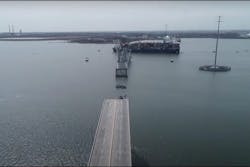Clean-up Efforts Underway at the Port of Baltimore
The clean-up of the Francis Scott Key Bridge in Baltimore began on Thursday as authorities called off the search for the missing bodies of the construction workers.
Several floating cranes sent by the U.S. Navy arrived to remove the remnants of the bridge that is blocking the Port of Baltimore. The U.S. Army Corps of Engineers said it would send over 1,100 engineering specialists and other experts to begin removing the debris.
The Army Corps of Engineers "is moving the largest crane on the Eastern Seaboard to Baltimore to help us," Maryland Governor Wes Moore said at a news conference Thursday evening.
Officials emphasized that reopening the port was their top priority and that teams needed to finish assessments to determine where to cut the bridge into pieces before they could start extracting it.
Federal officials announced the first relief funds of $60 million would go towards disaster recovery.
“No one will ever forget the shocking images of a container vessel striking the Francis Scott Key Bridge, causing its collapse and the tragic loss of six people,” U.S. Transportation Secretary Pete Buttigieg said in a news release. “The federal emergency funds we’re releasing today will help Maryland begin urgent work, to be followed by further resources as recovery and rebuilding efforts progress.”
The funds will aid the state’s ongoing debris removal, demolition, detours, and emergency repair efforts. The funds will also support the reconstruction and design of the bridge.
U.S. Coast Guard Rear Adm. Shannon Gilreath said at a news conference Thursday that the steps necessary to reopen the Port of Baltimore involve clearing debris from the channel, then removing the vessel and eventually removing the rest of the bridge debris from the waterway.
The first step in clearing the debris from the Francis Scott Key Bridge collapse will be dealing with the hazardous materials onboard the Dali.
There were 56 hazardous containers carrying 764 tons of hazardous materials, mostly corrosive or flammable liquids and, potentially, lithium-ion batteries. Some of the hazardous containers were damaged, according to the Coast Guard.
Officials have not given a timeline for how long that process will take, but infrastructure and salvage experts said the cleanup would pose a monumental challenge that includes frigid waters for divers having to cut steel beams and the 764 tons of hazardous materials that remain onboard the Dali.
------------------------------------------
Source: The Washington Post, TAG24 News
